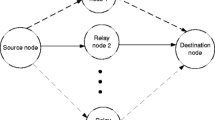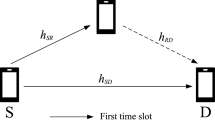Abstract
In current cooperative communication systems, a relay terminal is very often used as intermediate node and may degrade or improve the overall system performance, depending on the power imbalance between the hops. In this paper, an approach to estimate the performance of dual-hop fixed-gain relay system when each hop is subjected to extended generalized-K fading is presented. New closed form expressions are derived for the cumulative distribution function, the outage probability, and the ergodic capacity. Moreover, the average symbol error probability for coherent and non-coherent modulation schemes is derived. The accuracy of analytic results is verified through computer simulations.










Similar content being viewed by others
References
Karagiannidis, G. K., Zogas, D. A., Sagias, N. C., Tsiftsis, T. A., & Mathiopoulos, P. T. (2004). Multihop communications with fixed-gain relays over generalized fading channels. In Proceedings of IEEE Global Telecommunications Conference (pp. 36–40).
Goldsmith, A., & Wicker, S. B. (2002). Special issue on Energy-aware ad hoc wireless networks. In IEEE Wireless Communications (Vol. 9).
Hasna, M. O., & Alouini, M. S. (2004). A performance study of dual-hop transmissions with fixed gain relays. IEEE Transactions on Wireless Communications, 3(6), 1963–1968.
Hasna, M. O., & Alouini, M. S. (2003). End-to-end performance of transmission systems with relays over Rayleigh-fading channels. IEEE Transactions on Wireless Communications, 2(6), 1126–1131.
Hasna, M., & Alouini, M.-S. (2004). Harmonic mean and end-to-end performance of transmission systems with relays. IEEE Transactions on Communications, 52(1), 130–135.
Karagiannidis, G. K. (2006). Performance bounds of multi hop wireless communications with blind relays over generalized fading channels. IEEE Transactions on Wireless Communications, 5, 498–503.
Karagiannidis, G. K., Tsiftsis, T. A., & Mallik, R. K. (2006). Bounds for multi hop relayed communications in Nakagami-m fading. IEEE Transactions on Communications, 54, 18–22.
Ikki, S., & Ahmed, M. (2009). Performance analysis of dual hop relaying over non-identical Weibull fading channels. In Proceedings of IEEE VTC, Barcelona, Spain
Cvetković, A., Anastasov, J., Panić, S., Stefanović, M., & Milić, D. (2011). Performance of dual-hop relaying over shadowed ricean fading channels. Journal of Electrical Engineering, 62(4), 244–248.
Wu, L., Lin, J. , Niu, K., & He, Z. (2009). Performance of dual-hop transmissions with fixed gain relays over Generalized-K fading channels. In: IEEE International Conference on Communications 2009. ICC ‘09. (pp. 1–5).
Peppas, K., Mansour, A., & Tombras, G. (2010). Dual-hop transmissions with fixed-gain relays over generalized-gamma fading channels. Journal Telecommunication, 1(1), 87–93.
Ikki, S., & Ahmed, M. H. (2007). Performance analysis of dual-hop relaying communications over generalized gamma fading channels. In IEEE GLOBECOM.
Farhadi, G., & Beaulieu, N. C. (2008). On the ergodic capacity of wireless relaying systems over Rayleigh fading channels. IEEE Transactions on Wireless Communications, 7(11), 4462–4467.
Waqar, O., Ghogho, M., & McLernon, D. (2011). Tight bounds for ergodic capacity of dual-hop fixed-gain relay networks under Rayleigh fading. IEEE Communications Letters, 15(4), 413–415.
Costa, D. B., & Aïssa, S. (2009). Capacity analysis of cooperative systems with relay selection in Nakagami-m fading. IEEE Communications Letters, 13(9), 637–639.
Zhong, C., Matthaiou, M., Karagiannidis, G. K., Huang, A., & Zhang, Z. (2012). Capacity bounds for AF dual-hop relaying in generalized Gamma fading channels. IEEE Transactions on Vehicular Technology, 61(4), 1730–1740.
Yilmaz, F., & Alouini, M.-S. (2010). A new simple model for composite fading channels: Second order statistics and channel capacity. In Proceedings of 2010 International Symposium on Wireless Communication Systems, pp. 676–680.
Mathai, A., Saxena, R. K., & Haubold, H. J. (2010). The H-function: Theory and applications. Berlin: Springer.
Aloqlah, M. (2013). End-to-end performance analysis of dual-hop relaying systems over Extended Generalized K-fading channels. In 2013 20th International Conference on Telecommunications (ICT), pp. 1–4.
da Costa, D. B., & Yacoub, M. D. (2007). Dual-hop transmissions with semi-blind relays over Nakagami-m fading channels. Electronics Letters, 44(3), 214–216.
Bithas, P. S., Sagias, N. C., Mathiopoulos, P. T., Karagiannidis, G. K., & Rontogiannis, A. A. (2006). On the performance analysis of digital communications over Generalized-K fading channels. IEEE Communications Letters, 10(5), 353–355.
Peppas, K. P. (2012). A new formula for the average bit error probability of dual-hop amplify-and-forward relaying systems over generalized shadowed fading channels. IEEE Wireless Communications Letters, 1(2), 85–88.
Nabar, R. U., Bolcskei, H., & Kneubuhler, F. W. (2004). Fading relay channels: Performance limits and space-time signal design. IEEE Journal on Selected Areas in Communications, 22(6), 1099–1109.
Gradshteyn, I. & Ryzhik, I. M. (2000). Tables of integrals, series, and products (6th ed.). New York: Academic Press.
Schwartz, M., Bennett, W. R., & Stein, S. (1966). Communicarion systems and techniques. New York: McGraw-Hill.
Sagias, N. C., Zogas, D. A., & Karagiannidis, G. K. (2005). Selection diversity receivers over nonidentical Weibull fading channels. IEEE Transactions on Vehicular Technology, 54(6), 2146–2151.
Author information
Authors and Affiliations
Corresponding author
Rights and permissions
About this article
Cite this article
Aloqlah, M.S. Performance Analysis of Dual-Hop Fixed-Gain Relay Systems over Extended Generalized-K Fading Channels. Wireless Pers Commun 83, 619–630 (2015). https://doi.org/10.1007/s11277-015-2412-4
Published:
Issue Date:
DOI: https://doi.org/10.1007/s11277-015-2412-4




